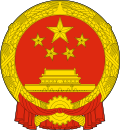City District (China)
City districts ( Chinese 市 轄區 / 市 辖区 , Pinyin shìxiáqū ) belong in the administrative structure of the People's Republic of China to the administrative units at the district level. There are currently 872 boroughs. (As of December 31, 2013) This number will continue to grow in the future, as every now and then cities and districts are converted into city districts. City districts are usually subordinate to the district-free cities , i.e. the district level. In the case of the four cities in China that are directly governed by the government ( Beijing , Tianjin , Shanghai , Chongqing ), however, they are directly subordinate to the provincial level, which has refrained from installing a district level at all.
Outwardly, city districts often appear like independent cities (in some cases they were also "independent" urban districts) and, like these, they often also encompass the surrounding area of the actual urban agglomeration, i.e. rural, agricultural areas.
The criterion for converting districts and urban districts into urban districts is in the first case the degree of urbanization in combination with the proximity to the center of an urban district, in the second case the actual or expected development of a merging of the urban catchment areas of the urban district to be dissolved with the / the central city district / s of a prefecture-level city.
Ethnic boroughs
The five ethnic city districts represent a special case in the administrative structure of the People's Republic of China. Each of these administrative units fulfills all requirements for the establishment of an autonomous district. However, since all the administrative units concerned are largely urban and are located within the centers of large, district-free cities, according to the administrative regulations no districts, but rather city districts had to be established. The law on ethnic regional autonomy now again only provides for autonomous districts at the district level, but not for autonomous city districts. This situation led to the consequence that the affected city districts - similar to the nationality communities - have the ethnic designation in their names and also have some special rights specified in each individual case, but do not belong to the autonomous administrative divisions and do not have the same rights as autonomous districts . The five ethnic boroughs are:
- Province of Heilongjiang :
- Meilisi der Daur ( 梅里斯 达斡尔 族 区 ) district, Qiqihar city ;
- Province Henan :
- Chanhe the Hui ( 瀍 河 回族 区 ) District , Luoyang City ;
- Hui Guancheng District ( 管 城 回族 区 ), Zhengzhou City ;
- Shunhe Hui District ( 顺河 回族 区 ), Kaifeng City ;
- Inner Mongolia Autonomous Region :
- Huimin District ( 回民 区 ), Hohhot City .
literature
- Sebastian Heilmann : Political System, 3rd People's Republic. In: Stefan Friedrich, Hans-Wilm Schütte, Brunhild Staiger (eds.) The great China Lexicon. History, geography, society, politics, economy, education, science, culture. Wissenschaftliche Buchgesellschaft, Darmstadt 2003, ISBN 3-534-14988-2 , pp. 575-578.
- Erling von Mende , Heike Holbig: Local administration. In: Stefan Friedrich, Hans-Wilm Schütte, Brunhild Staiger (eds.) The great China Lexicon. History, geography, society, politics, economy, education, science, culture. Wissenschaftliche Buchgesellschaft, Darmstadt 2003, ISBN 3-534-14988-2 , pp. 456–458.
- Meyer's Atlas China. On the way to world power. Bibliographisches Institut AG, Mannheim 2010, ISBN 978-3-411-08281-0 , pp. 92-93.
- Yin Zhongqing (尹中卿): The political system in China today. China Intercontinental Press, Beijing 2004, ISBN 7-5085-0470-4 .
